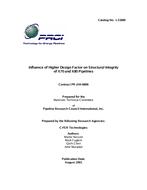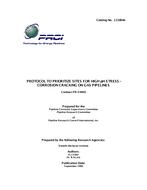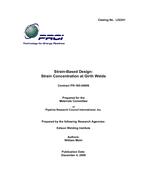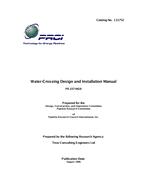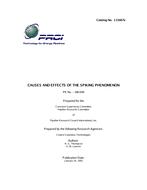Provide PDF Format
PRCI PR-244-9806
- Influence of Higher Design Factor on Structural Integrity of X70 and X80 Pipelines
- Report / Survey by Pipeline Research Council International, 08/01/2001
- Publisher: PRCI
$448.00$895.00
L51880e
C-FER Technologies, Inc.
Need: Most pipelines in Class 1 areas are currently designed to a utilization factor of 0.72 using steel grades of up to X70. Using higher strength steels and/or a higher design factor can reduce the wall thickness and construction cost of such pipelines. High strength steels tend to have high yield-to-tensile ratios and lower overall post-yield tangent stiffness. This raises concerns about the potential for excessive plastic deformations under high hydrostatic test pressures. Combined with a high design factor, high steel grades will also lead to thinner pipe walls and reduced tolerance to thickness-dependent failure mechanisms such as corrosion, cracks, and dent-gouges.
Result: The issues considered in evaluating the feasibility of high-strength high-design-factor pipelines were:
- Pressure test limits. The rationale behind current mill and field test criteria was examined to assess whether applying such criteria will lead to unacceptable rejection rates due to excessive plastic deformation and manufacturing defects.
- In-service reliability. Long-term reliability with respect to seam weld cracks, corrosion and mechanical damage was analyzed to determine whether adequate reliability levels could be maintained without excessive maintenance requirements.
- Life cycle cost. The lifetime economic implications were evaluated based on a comparison between the cost savings achieved by reducing the wall thickness and the potential increases in the cost of inspection and prevention activities needed to maintain adequate reliability.
Benefit: The assessment utilized a reliability-based approach in which deterministic models of pipe behavior were combined with statistical distributions of pipe characteristics to evaluate the expected failure rates under testing and service conditions. A number of test cases representing feasible pressure/diameter combinations for steel grades of up to X80 and a design factor of up to 0.8 were analyzed under typical and severe loading and resistance assumptions. The results were used to assess reliability under testing and in-service conditions and to examine wall-thickness related life cycle costs.
C-FER Technologies, Inc.
Need: Most pipelines in Class 1 areas are currently designed to a utilization factor of 0.72 using steel grades of up to X70. Using higher strength steels and/or a higher design factor can reduce the wall thickness and construction cost of such pipelines. High strength steels tend to have high yield-to-tensile ratios and lower overall post-yield tangent stiffness. This raises concerns about the potential for excessive plastic deformations under high hydrostatic test pressures. Combined with a high design factor, high steel grades will also lead to thinner pipe walls and reduced tolerance to thickness-dependent failure mechanisms such as corrosion, cracks, and dent-gouges.
Result: The issues considered in evaluating the feasibility of high-strength high-design-factor pipelines were:
- Pressure test limits. The rationale behind current mill and field test criteria was examined to assess whether applying such criteria will lead to unacceptable rejection rates due to excessive plastic deformation and manufacturing defects.
- In-service reliability. Long-term reliability with respect to seam weld cracks, corrosion and mechanical damage was analyzed to determine whether adequate reliability levels could be maintained without excessive maintenance requirements.
- Life cycle cost. The lifetime economic implications were evaluated based on a comparison between the cost savings achieved by reducing the wall thickness and the potential increases in the cost of inspection and prevention activities needed to maintain adequate reliability.
Benefit: The assessment utilized a reliability-based approach in which deterministic models of pipe behavior were combined with statistical distributions of pipe characteristics to evaluate the expected failure rates under testing and service conditions. A number of test cases representing feasible pressure/diameter combinations for steel grades of up to X80 and a design factor of up to 0.8 were analyzed under typical and severe loading and resistance assumptions. The results were used to assess reliability under testing and in-service conditions and to examine wall-thickness related life cycle costs.
Related Products
PRCI PR-003-9403
Protocol to Prioritize Sites for High pH Stress-Corrosion Cracking in Gas Pipelines..
$448.00 $895.00

